Wheat to millet, discover how grains in the Bible symbolize more than sustenance, revealing deep spiritual meanings and traditions.

Grains in the Bible
You might not be aware that grains play a more significant role in the Bible than merely serving as a staple food for ancient societies. These humble seeds are woven into the fabric of numerous parables, laws, and rituals, symbolizing everything from sustenance to spiritual purity.
As we explore the roles of wheat, barley, spelt, millet, and rye, you'll start to see these grains in a new light. Beyond their nutritional value, they carry deep symbolic meanings that have influenced religious practices and daily life.
Let's embark on a journey to uncover these hidden layers, which promise to enrich your understanding of biblical texts.
Key Takeaways
- Grains symbolize divine provision, prosperity, and the interconnectedness of physical and spiritual nourishment in the Bible.
- Wheat and barley hold special significance in religious rituals, representing renewal, thanksgiving, and spiritual sustenance.
- The cultivation and consumption of grains like barley, spelt, and millet reflect ancient societies' deep understanding of agriculture and dietary health.
- Grains are central to biblical narratives, illustrating God's generosity, the importance of communal celebration, and covenantal relationships.
The Role of Wheat
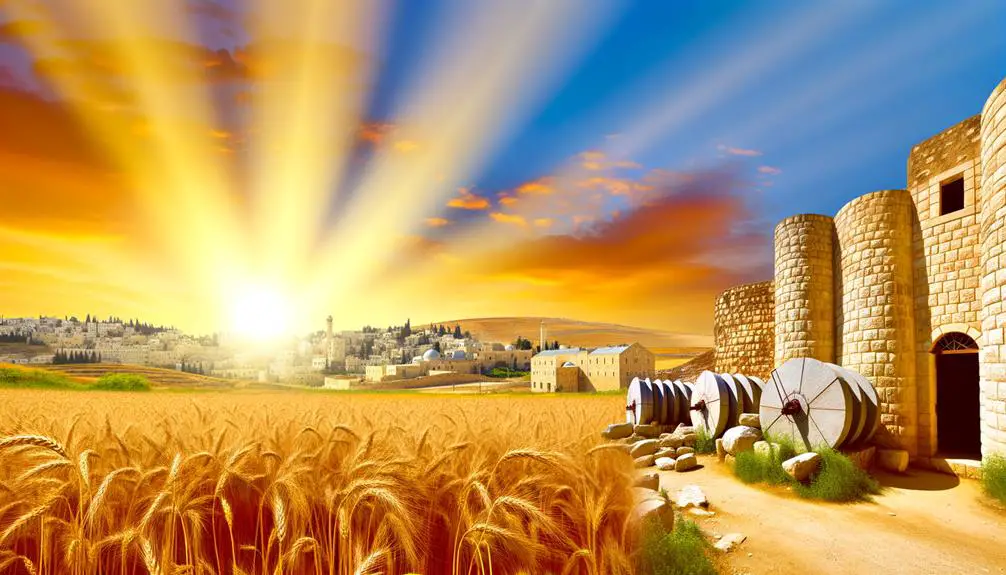
Wheat's significance in the Bible extends beyond mere sustenance, embodying themes of fertility, prosperity, and divine provision. As you delve into the scriptures, you'll notice that wheat frequently appears not just as a dietary staple but as a potent symbol laden with deeper meanings. This grain's role is multifaceted, intertwining with the agricultural cycle to highlight moments of communal celebration and reflection through harvest festivals.
Wheat symbolism in biblical texts often parallels spiritual nourishment and the bounty of the land, reflecting God's generosity towards His people. It's a motif that underscores a covenantal relationship, where adherence to divine laws ensures the flourishing of both land and community. The harvest festivals, notably Shavuot or the Feast of Weeks, further amplify this symbolism. Originally an occasion to mark the wheat harvest, it transformed into a time of rejoicing in God's provision and remembering His law given at Sinai.
This connection between the physical harvest and spiritual enrichment invites you to consider how sustenance extends beyond the material. The rituals and celebrations associated with wheat harvests aren't merely about thanking God for the physical food but recognizing the broader spectrum of His provision — encompassing law, land, and lore.
Analyzing wheat's role in the Bible thus provides a window into understanding how ancient societies perceived their relationship with the divine through the prism of agricultural practices. It's a testament to how intertwined spiritual beliefs and everyday life were, with wheat serving as a key link between heaven and earth.
Barley: Beyond Bread
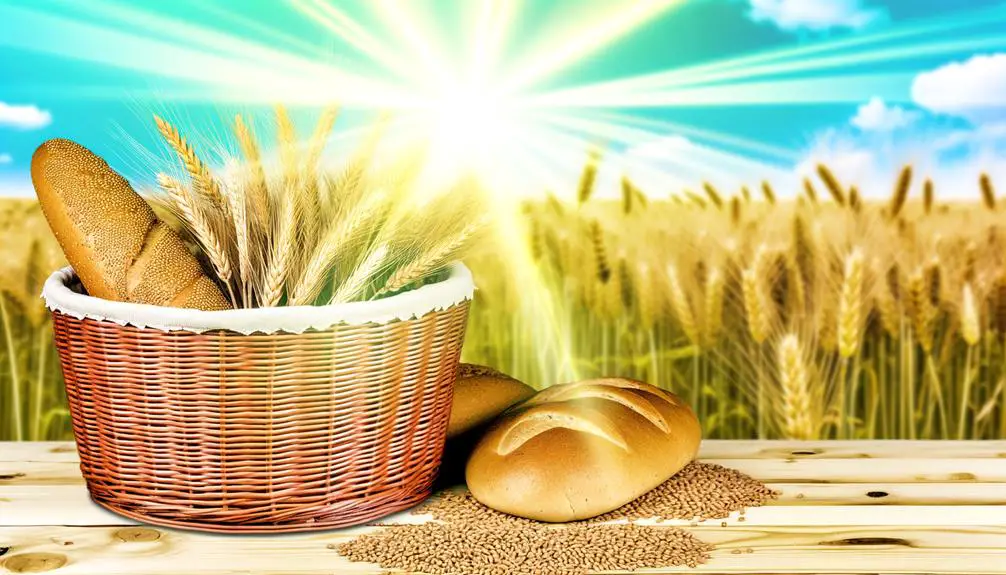
Barley, often overshadowed by wheat in biblical narratives, plays a pivotal role that extends beyond its basic use as bread-making grain, revealing deeper layers of spiritual and cultural significance. This robust grain, integral to ancient diets, held a multifaceted role in society. You'll find that barley cultivation wasn't just an agricultural practice; it was a backbone of civilization. Its resilience in various climates made it a staple, ensuring the sustenance of communities.
Diving into the health benefits, you'll uncover that barley wasn't just food but also medicine. Rich in fiber, vitamins, and minerals, it supported the overall health of ancient populations, contributing to their dietary resilience. Its consumption was believed to strengthen one's physical constitution, which was essential in times when healthcare was rudimentary at best.
Moreover, barley's significance transcends the physical realm, touching spiritual and ritualistic aspects of life. It often symbolized abundance, fertility, and renewal—themes recurrent in biblical teachings. Its presence in offerings and ceremonies underscored its importance in connecting the material and spiritual worlds.
As you explore this grain's journey through history, you'll recognize that barley's story isn't just about agricultural success; it's about humanity's relationship with the earth and the divine. Its cultivation and consumption weave a narrative of resilience, health, and spiritual significance, offering insights into the lives of those who once walked the lands of the Bible.
In essence, barley's role in biblical times goes far beyond its application in bread-making. It symbolizes a deeper understanding of life, health, and spiritual connection, making it a grain of profound historical and cultural importance.
Spelt and Ancient Diets
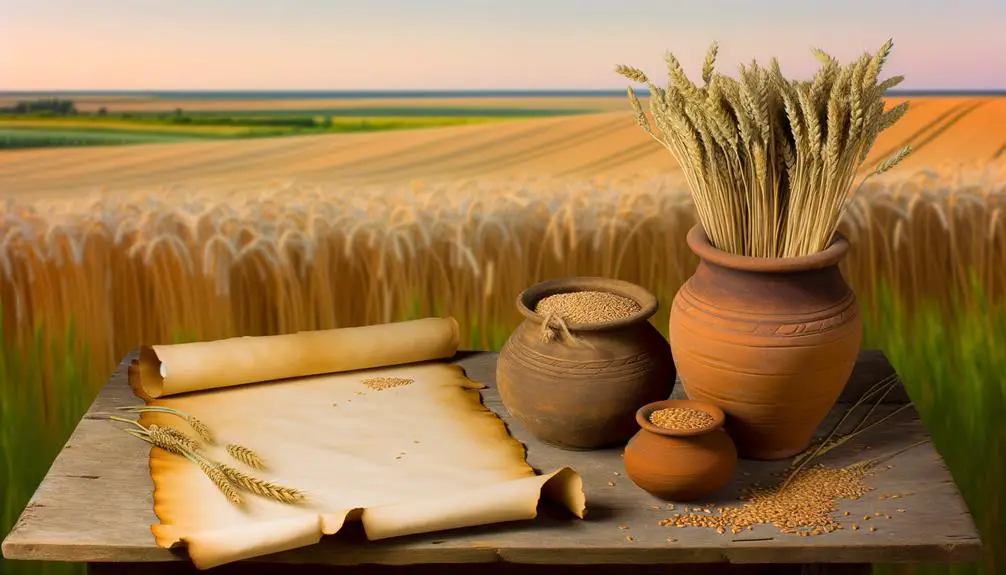
Turning our attention to spelt, we find another grain integral to ancient diets, offering a rich tapestry of nutritional, cultural, and economic relevance. Spelt, a species of wheat that was widely cultivated in the ancient world, particularly in the Near East and Europe, played a pivotal role in feeding ancient civilizations. Its resilience in diverse climates and soils made it a staple of ancient cultivation practices.
Spelt nutrition is remarkable for its high protein content, along with significant levels of minerals and vitamins. This grain was more than a mere food source; it was a foundation of health in ancient diets, providing sustenance and strength to populations. Ancient texts and archaeological finds suggest that spelt was highly valued not just for its nutritional profile but also for its versatility in cooking and baking.
To understand the significance of spelt in ancient diets, consider the following table that contrasts spelt with other ancient grains:
Grain |
Protein Content |
Mineral Richness |
Versatility in Cooking |
|---|---|---|---|
Spelt |
High |
High |
High |
Barley |
Medium |
Medium |
Medium |
Wheat |
High |
High |
High |
The table highlights spelt's competitive edge in terms of nutrition and culinary use, underscoring its importance in ancient dietary practices. Its cultivation, requiring less fertilization and being more disease-resistant compared to other grains, further underscores its role in ancient agricultural systems. Thus, spelt's contribution to ancient diets transcends mere sustenance, reflecting a deep understanding of agricultural practices, dietary health, and the socioeconomic fabric of ancient societies.
Millet in Biblical Times
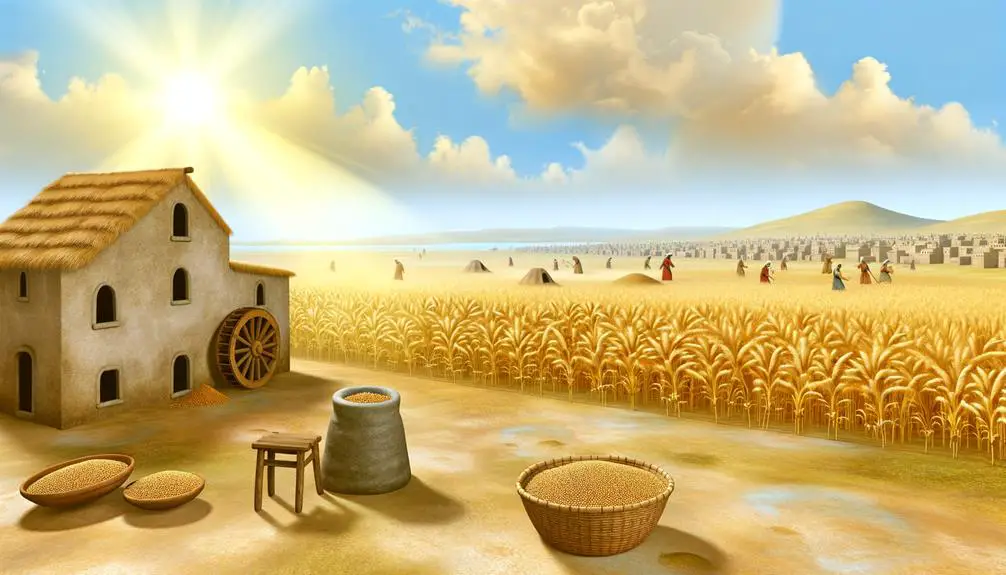
Exploring the role of millet, you'll find its significance extended beyond mere sustenance, serving as a vital component of biblical times' diet and cultural practices. Millet cultivation, deeply rooted in the agricultural traditions of the ancient Near East, wasn't merely a testament to the ingenuity of early farmers but also a reflection of the grain's adaptability and resilience. These small-seeded grains, encompassing a variety of species, were integral to the fabric of daily life, providing a reliable source of nutrition in the face of unpredictable climates and harsh growing conditions.
Delving deeper into millet varieties, it becomes evident that their diversity was a cornerstone of ancient agronomy. Each variety possessed unique characteristics, making them suited to specific climates and soils. This versatility ensured that millet could be grown across a wide geographical expanse, from the arid regions to the more temperate zones, thus securing its place as a staple in the diets of many biblical communities.
Millet's role extended beyond the plate; it was entwined with the cultural and religious practices of the time. Its cultivation and harvest were often associated with rituals and festivities that underscored the grain's importance to societal well-being and prosperity. These practices reflected a deep-seated reverence for the earth's bounty and an understanding of the intricate relationship between humans, their food sources, and the divine.
Rye: A Lesser-Known Grain
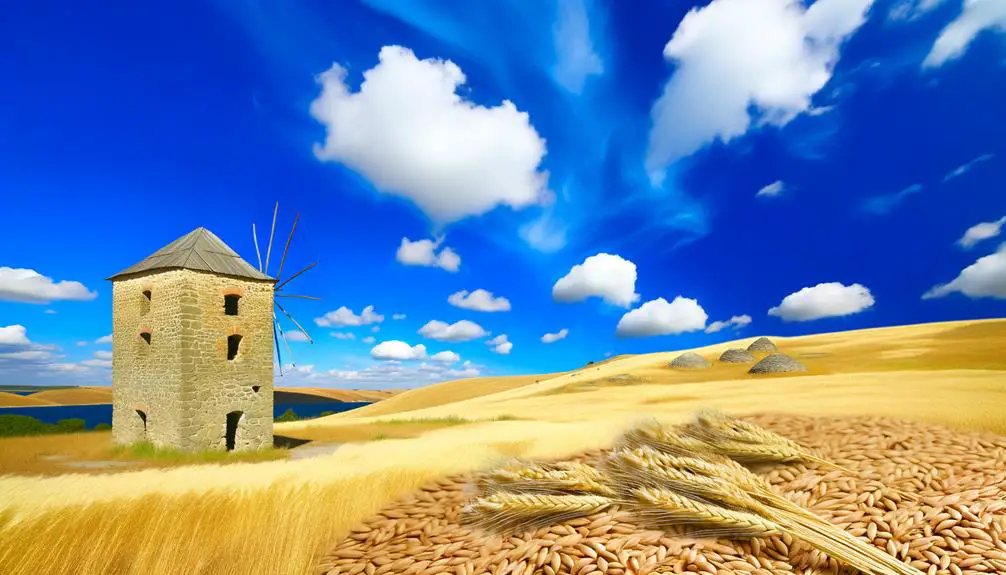
While millet held a celebrated position in biblical diets, rye emerges as a lesser-known yet historically significant grain within these ancient communities. Its cultivation, less documented than that of wheat or barley, played a crucial role in diversifying the dietary staples of the time. You'll find that rye's resilience in colder climates and poorer soils made it a vital crop for regions less suited to traditional grains. This adaptability allowed rye to quietly underpin parts of the ancient diet, particularly in areas where other grains struggled to thrive.
However, the cultivation of rye wasn't without its challenges. Rye diseases, notably ergot, a fungal infection that can lead to serious health issues, posed a significant risk. The biblical communities, reliant on their crops for sustenance, had to navigate these threats with the knowledge and tools at their disposal. Their strategies for managing rye diseases, though not explicitly detailed in biblical texts, likely involved early forms of crop rotation and selective harvesting, practices that would minimize the impact of diseases on their crucial food sources.
Analyzing rye's role in these ancient diets offers you a window into the agricultural practices and nutritional strategies of biblical times. It underscores the importance of lesser-known grains in sustaining communities, highlighting the adaptability and resilience required to manage the challenges of rye cultivation. This grain's story enriches our understanding of ancient agricultural systems, providing a nuanced perspective on the diversity and complexity of biblical diets.
Grains in Religious Rituals

In analyzing grains within religious rituals, you'll find their symbolism deeply rooted in biblical narratives. Grain offerings, for instance, underscore a profound act of faith and subsistence, reflecting a tangible expression of gratitude.
Moving forward, you'll see how barley's association with Passover and wheat's role in Communion rituals encapsulate their integral positions in fostering spiritual and communal bonds.
Grain Offerings Significance
Grain offerings, integral to ancient religious rituals, symbolize devotion and gratitude toward the divine. These offerings served multiple purposes, not only as acts of worship but also as expressions of thanksgiving or supplication for blessings. The cultural symbolism embedded within grain offerings was profound, reflecting a society's reliance on agriculture and its understanding of the sacred-profane dichotomy.
Grain Type |
Offering Purposes |
Cultural Symbolism |
|---|---|---|
Wheat |
Thanksgiving |
Fertility, abundance |
Barley |
Supplication |
Humility, sustenance |
Oats |
Remembrance |
Resilience, life cycles |
Rye |
Purification |
Renewal, cleansing |
Millet |
Covenantal bonds |
Community, interdependence |
Through this lens, you can appreciate the depth of meaning grain offerings held for ancient communities, symbolizing not just their material needs but their spiritual aspirations and societal values.
Barley and Passover
Reflecting on the significance of grain offerings, it's crucial to explore how barley plays a pivotal role during Passover, anchoring the festival's rituals in historical and theological contexts. This deep dive reveals:
- Harvest Timing: Barley's harvest coincides with Passover, symbolizing renewal and sustenance. This timing isn't coincidental but deeply woven into the fabric of the celebration, marking a period of both physical and spiritual rebirth.
- Nutritional Value: Its nutritional profile underscores its selection; barley sustains and nourishes, reflecting the provision of needs during times of hardship and journey.
- Theological Significance: Barley, as the first grain harvested, represents the first fruits offered to God, highlighting themes of gratitude, dependence, and the sanctity of the agricultural cycle within the Passover narrative.
Analyzing these elements, you gain insight into barley's indispensable role during Passover, underscoring its multifaceted significance beyond mere sustenance.
Wheat in Communion
As we delve into the role of wheat in Communion, it's essential to recognize its profound symbolism and historical significance within Christian rituals.
Aspect |
Significance |
|---|---|
Symbolism |
Wheat represents the body of Christ, embodying sacrifice and resurrection. |
Harvest Celebrations |
Ties Communion to agricultural cycles, bridging the sacred and the mundane. |
Gluten Significance |
Challenges and adapts practices for those with gluten sensitivities. |
Wheat's inclusion in Communion not only connects worshippers to the agricultural foundations of early Christian communities but also to the cyclical nature of life and death, mirroring Christ's resurrection. Its gluten, while a point of contention for some, has prompted a broader discussion on inclusivity within the ritual, ensuring it remains a unifying act of faith across diverse communities.
Frequently Asked Questions
How Did the Agricultural Practices for Growing Grains in Biblical Times Compare to Modern Techniques?
Focusing on agricultural practices, you'll find that modern techniques vastly differ from those of biblical times, especially in growing grains. Nowadays, you're looking at advanced genetic modification and sophisticated irrigation systems, which were unimaginable back then. These innovations boost yields and resilience against pests and climate changes.
Contrastingly, ancient methods relied heavily on natural rainfall and traditional seed selection, lacking the technological advancements and scientific knowledge you take for granted today.
Were There Any Specific Grains Mentioned in Biblical Texts That Are No Longer Cultivated or Consumed Today?
You're diving into a sea of ancient grains, wondering if any have vanished from our tables. Grain preservation techniques and Biblical dietary laws played a crucial role in what was cultivated and consumed.
Analyzing these texts, you'll find that most grains mentioned are still around, though some, like certain ancient wheats, have become rarities.
This exploration isn't just about food; it's a window into past lives, agricultural practices, and cultural priorities.
How Did the Consumption of Grains in Biblical Times Influence the Health and Nutrition of Ancient Populations?
The consumption of grains significantly influenced ancient populations' health and nutrition. Grain fermentation and adherence to dietary laws ensured that these communities received essential nutrients while minimizing foodborne illnesses.
This practice of fermenting grains not only enhanced their nutritional profile but also introduced beneficial probiotics into their diet. Consequently, these dietary habits contributed to the overall well-being and longevity of ancient societies, demonstrating a sophisticated understanding of food science and health.
Can We Find Evidence of Grain Trade Routes or the Exchange of Grain Varieties Between Different Ancient Civilizations Mentioned in the Bible?
Yes, you can find evidence of ancient civilizations exchanging grain varieties and establishing trade networks. These interactions hint at sophisticated grain preservation techniques and the beginnings of global commerce.
Analyzing archaeological findings and historical texts, scholars have pieced together routes that not only facilitated the exchange of goods but also ideas and cultures. This network of trade was instrumental in shaping the dietary habits and economic structures of these societies.
How Did Climate and Geographical Differences Within the Regions Mentioned in the Bible Affect the Types of Grains That Could Be Grown and Harvested?
You're exploring how climate and geographical differences influence the cultivation of grains. Rainfall patterns and soil types are critical factors.
Areas with abundant rainfall and fertile soil support a wide variety of grains, while arid regions with poor soil might limit the types of grains that can be grown. This variation affects what's harvested in different regions.
Understanding these environmental impacts provides insight into agricultural practices and grain diversity across various landscapes.
Conclusion
In the tapestry of biblical narratives, grains aren't merely sustenance but threads intertwining culture, economy, and spirituality. From the golden sheaves of wheat to the humble barley loaf, each grain tells a story of survival, resilience, and divine provision.
They're not just footnotes in ancient diets but pivotal in religious rituals, symbolizing fertility, prosperity, and divine blessings. Thus, understanding these grains is akin to unlocking a chest of historical and theological treasures, enriching our comprehension of biblical times.



Sign up